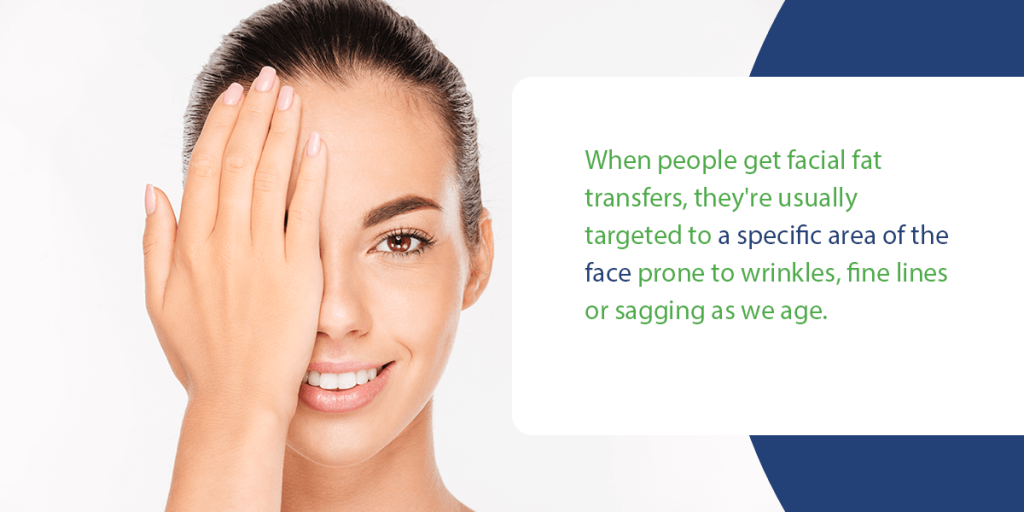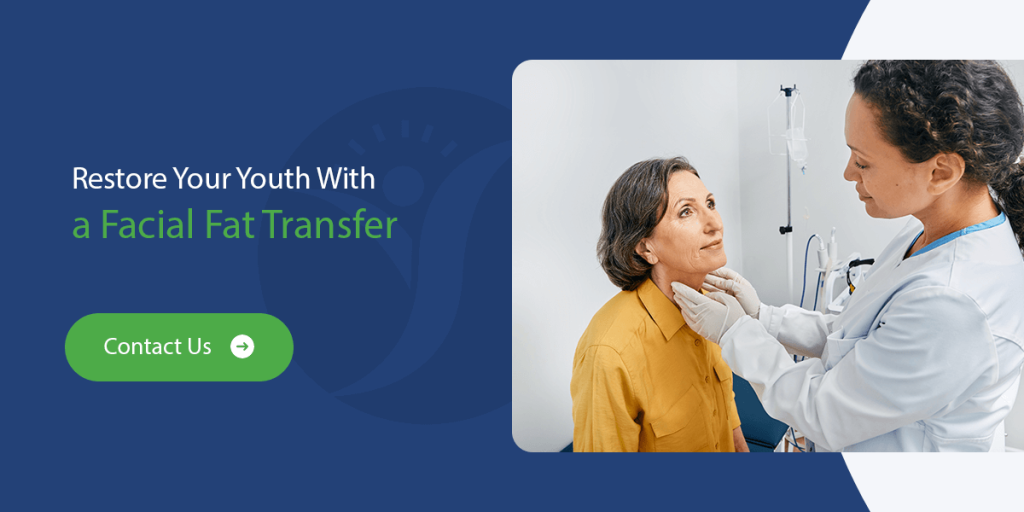
Below, you’ll learn everything you need to know about facial fat transfers, including what they are, how they work, what the procedure looks like and how long the treatment lasts. We’ve compiled all this information to make it easier for you to make an informed decision about your next treatment.
What Is a Facial Fat Transfer?
As we age, the fat in our face that gives us a soft, youthful appearance starts to deteriorate, especially around the jawline and neck. Once this process begins, it can create pronounced wrinkles, fine lines and drooping.
A facial fat transfer is a popular cosmetic procedure that helps balance texture, fill out groves and flatten wrinkles. The treatment helps add or restore volume to different parts of the face, helping bring back a youthful appearance. Fat transfers to the face are often the ideal choice for many individuals since they’re minimally invasive, non-surgical and more natural than implants or fillers.
How Does a Facial Fat Transfer Work?
The facial fat transfer procedure can often be performed under local anesthesia or sedation to ensure the patient’s comfort. Once a patient has been numbed or put to sleep, the process begins with the doctor removing fatty tissue from other areas of the body through liposuction, such as the thighs, abdomen or flanks. These areas are discussed beforehand so that the procedure helps patients remove unwanted fat from one area to repurpose it in another.
Once the fat is removed, it’s processed through centrifuging and enriched by platelet-rich plasma created using a sample of your blood. This process helps purify the fat so it’s ready to be injected into your face. The fat can even be processed further through manual filtration, creating “nanofat” or “mircofat.”
Once the fat has been purified to the desired level, it’s prepared in syringes for injection. A professional will inject the fat into targeted areas of the face, helping patients address specific issues. The facial fat transfer will start to instantly add volume to the skin, soften fine lines, balance texture and create a youthful appearance. Between injections, the doctor may manually massage the targeted area to help smoothen out the injection and ensure it’s even and natural-looking.
Where Can You Transfer Fat on the Face?

When people get facial fat transfers, they’re usually targeted to a specific area of the face prone to wrinkles, fine lines or sagging as we age. There are many places you can transfer fat to on the face and issues you can address, including:
- Weak jawlines
- Thin lips
- Hallow cheeks
- Sunken circles or bags under the eyes
- Grooves that go from the corners of the mouth to the nose
- Sunken features in the contours of the face
- Undefined cheekbones
- Nasolabial folds
- Folds or wrinkles around the face
- Lines that appear between the lower eyelids and cheeks
These are just a few issues you can tackle through facial fat transfers. The procedure helps add volume to specific areas, helping target an array of problems, such as wrinkles, deep lines or hallowed features. Fat transfers can help you achieve a youthful, plump appearance that often fades with age, helping you improve your confidence and self-esteem.
What Is the Facial Fat Grafting Procedure Like?
The procedure starts with local, IV or general anesthesia. You can talk with your doctor about which option you’d prefer, as local anesthesia will numb targeted areas while IV sedation will relax you, potentially putting you to sleep. General anesthesia puts you to sleep, and you’ll wake up once the procedure is complete.
Once you’ve been administered anesthesia, the surgeon will remove fat from donor sites like the thigh or flanks. The surgeon will clean the fat through centrifuging, and since the fat comes from your own body, there’s no chance that your body will reject the fat after the procedure.
The surgeon will inject the fat through a tiny incision, passing it in and out of the area multiple times as needed. This process is repeated multiple times until the desired look is achieved in the targeted areas.
Once a person completes the procedure, they’ll have to take care during the recovery process to ensure they receive the best results once healed. The recovery process includes:
- Mild or moderate swelling that lasts several days.
- Wearing compression bandages for at least two weeks, which can be taken off for showers.
- Pain management with over-the-counter or prescription medication.
- Soft washing of the face, but no rubbing.
- Waiting for a few weeks before returning to exercise or physical activity.
- Sleeping with an elevated head on your back for the first few weeks.
- Bruising that usually resolves itself in two to three weeks.
After the procedure, you can potentially return to work after three to seven days, depending on your comfort level. If your job is labor intensive, then it’s best to wait until you’ve recovered more before putting your body through the excess strain.
How Long Does Facial Fat Grafting Last?
Fat transfers are considered permanent, but the overall retention might not be 100%, meaning that you might need to get a touch-up after your first appointment to ensure that you achieve your ideal look. However, fat injections in the face can last for years, decades or even longer in some cases. This procedure is ideal for individuals who want lasting results and don’t want to come back in for another round of treatment like you would with dermal fillers.
However, it’s important to remember that facial fat grafting doesn’t stop the aging process. While it can address current aging symptoms, things will slightly diminish over time as a person ages. Taking good care of your skin — wearing sunscreen, practicing good skin care and eating a healthy diet — can help reduce the onset of the symptoms of aging that you’re trying to target, like wrinkles, fine lines and sunken features.
Restore Your Youth With a Facial Fat Transfer
Fat transfers can last for a long time, helping you sustain a youthful and plump appearance as you age. Synergy Wellness is here to help you achieve your goals through mini fat transfer. We help you target symptoms of aging or features that might make you self-conscious, such as textural imbalances, wrinkles, grooves and more. Our treatment is minimally invasive, helping you achieve your ideal look without having to go through a life-altering procedure.
Our procedure is safe and effective, helping you improve your confidence without putting your health at risk. You’ll work with our professional team to come up with a treatment plan that’s right for you. Contact us today to learn more or to schedule a consultation!




